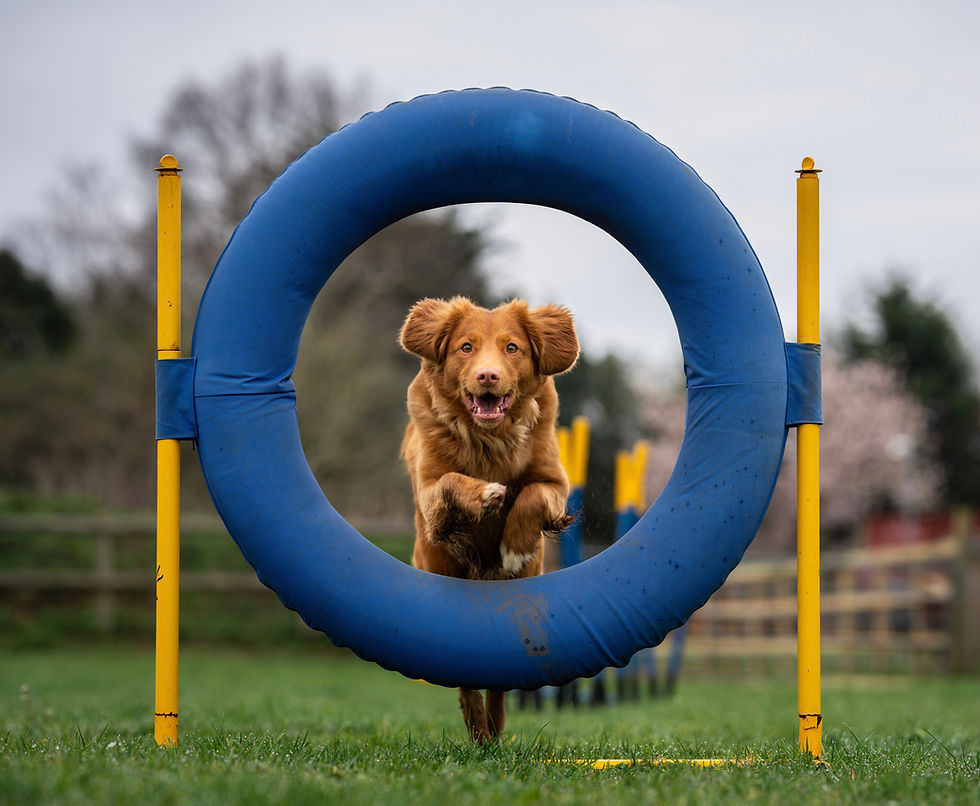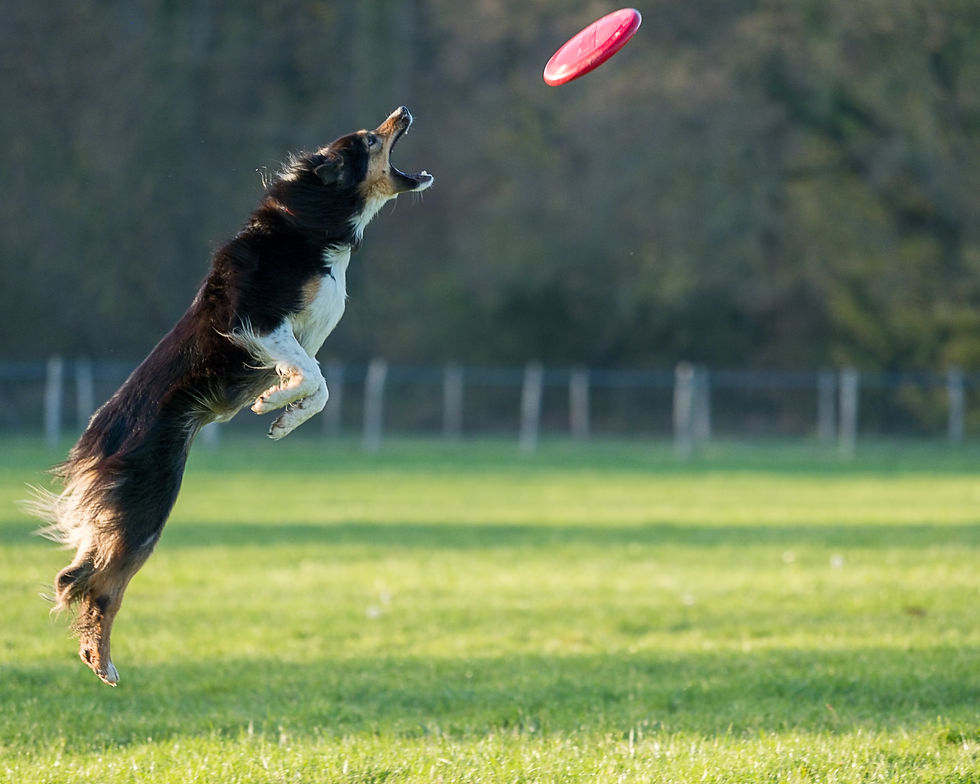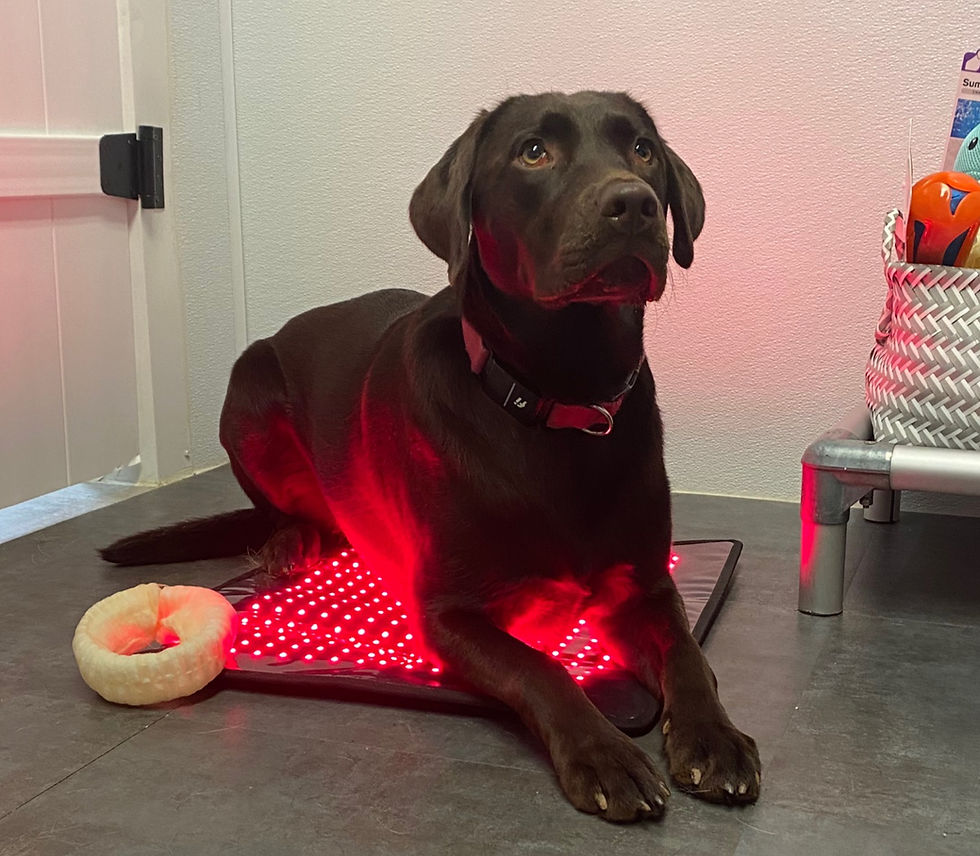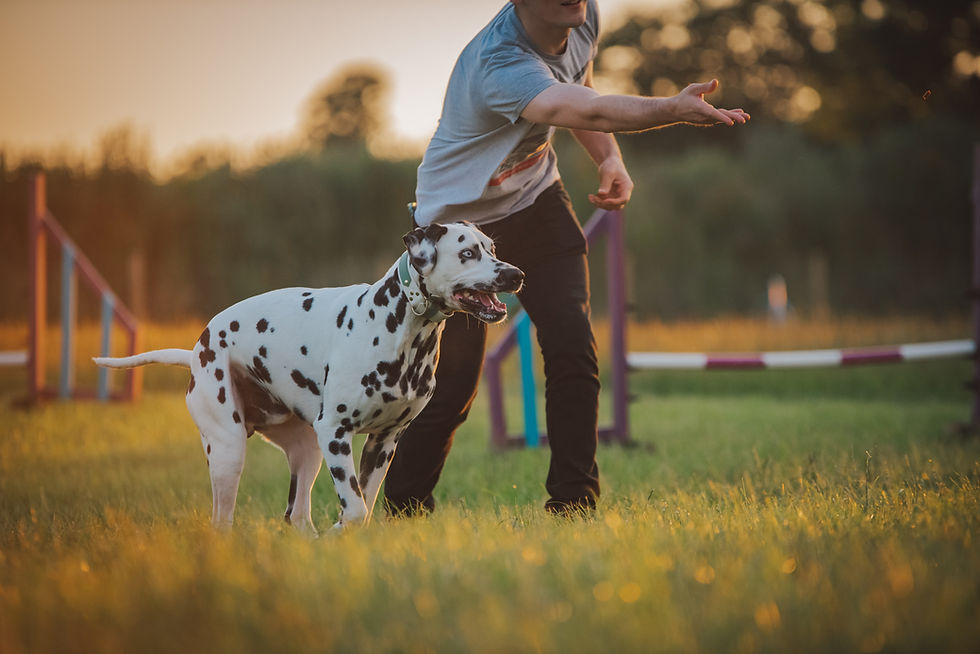Canine Fitness Trends: Keeping Your Pup in Peak Condition
- stephanie pope
- Mar 11, 2024
- 12 min read
Updated: May 20, 2025

Canine fitness is an essential aspect of a dog's overall health and well-being. Just like humans, dogs need regular exercise to maintain a healthy weight, build muscle strength, and improve cardiovascular health. Regular physical activity can also help prevent obesity, reduce the risk of chronic diseases, and promote mental stimulation and emotional well-being in dogs.
In recent years, there has been a surge in new and exciting trends in dog fitness. From agility training to specialized exercise programs, dog owners are exploring innovative ways to keep their furry friends in peak condition. These trends not only provide physical benefits but also offer mental stimulation and socialization opportunities for dogs. In this blog, we will explore some of the latest trends in dog fitness and how they can benefit your canine companion.
Agility Training

Agility training is a dog sport that involves navigating a series of obstacles in a timed course. It requires dogs to use their physical and mental abilities to complete the course accurately and quickly. Agility training courses are offered by various organizations, including local dog training clubs, agility schools, and online platforms. These courses range from beginner to advanced levels and cater to different breeds and sizes of dogs.
Agility training equipment includes:
Jumps: Dogs leap over hurdles of varying heights.
Tunnels: Dogs navigate through collapsible tunnels.
Weave Poles: Dogs weave through a series of upright poles.
Seesaws: Dogs balance on a seesaw, with one end touching the ground.
A-Frames: Dogs climb up and down a steeply angled frame.
Dog Walks: Dogs walk across a narrow plank elevated above the ground.
Agility training offers numerous benefits
Physical Exercise: Agility training provides a full-body workout for dogs, helping them build strength, endurance, and flexibility.
Mental Stimulation: The complex nature of agility courses requires dogs to think and problem-solve, providing mental stimulation and preventing boredom.
Bonding: Agility training strengthens the bond between dogs and their owners, as it requires teamwork and communication.
Confidence Building: Successfully completing agility obstacles boosts a dog's confidence and self-esteem.
Overall, agility training is a fun and rewarding way to keep dogs physically and mentally fit. It offers numerous benefits and can be enjoyed by dogs of all ages and breeds.
Scent Work

Scent work, also known as nose work or scent detection, is a canine activity that taps into a dog's natural ability to use their sense of smell. It's a fun and mentally stimulating activity that can be enjoyed by dogs of all ages, breeds, and sizes. In scent work, dogs are trained to locate specific scents or objects hidden in various environments, such as indoors, outdoors, or even in vehicles. This activity not only provides physical exercise but also engages a dog's brain, making it an excellent way to keep them mentally sharp and entertained.
Benefits of Scent Work for Dogs
Mental Stimulation: Scent work engages a dog's sense of smell, which is their most powerful and important sense. It requires them to use their brains to locate and identify specific scents, providing mental stimulation and preventing boredom.
Physical Exercise: While scent work may not be as physically demanding as some other activities, it still requires dogs to move around and use their bodies to search for scents. This provides a moderate level of physical exercise, which is important for a dog's overall health and well-being.
Bonding: Scent work is often done as a team activity between a dog and their owner or handler. This strengthens the bond between them as they work together to achieve a common goal.
Confidence Building: Successfully locating scents and objects in scent work can boost a dog's confidence and self-esteem.
Versatility: Scent work can be done in various environments, making it a versatile activity that can be enjoyed indoors, outdoors, or even in different locations such as parks, buildings, or vehicles.
Getting Started with Scent Work

Basic Training: Start by teaching your dog the basic commands needed for scent work, such as "search," "find it," and "alert."
Scent Introduction: Introduce your dog to the specific scent or object they will be searching for. This can be done by placing the scent on a cotton swab or small item and allowing your dog to sniff it.
Hide and Seek: Start with simple hiding spots and gradually increase the difficulty as your dog becomes more proficient. You can hide the scent in various locations, such as under furniture, inside boxes, or outdoors in the yard.
Positive Reinforcement: Use treats, praise, and rewards to reinforce your dog's success in finding the scent. This will encourage them to continue searching and make the activity more enjoyable.
Practice Regularly: Like any skill, scent work requires practice to improve. Set aside regular time for scent work sessions with your dog to keep their skills sharp.
Overall, scent work is a fun and rewarding activity that provides mental and physical exercise for dogs. It's a great way to keep them entertained, engaged, and mentally sharp, and it can be enjoyed by dogs of all ages and breeds. Whether you're looking for a new activity to try with your dog or want to provide them with a stimulating and enriching experience, scent work is an excellent choice.
Canine Sports

Canine sports are a diverse range of activities that dogs and their owners can participate in together. These sports often mimic tasks that dogs were originally bred for, such as herding, retrieving, and hunting. Some popular canine sports include:
Flyball: A relay race where dogs jump over hurdles, trigger a spring-loaded box to release a tennis ball, and then return with the ball to their handler.
Dock Diving: Dogs jump off a dock into a pool of water, competing for distance or height.
Disc Dog: Dogs catch flying discs thrown by their handlers, often performing acrobatic catches and jumps.
Benefits of Participating in Canine Sports for Dogs and Owners
Physical Exercise: Canine sports provide dogs with a fun and challenging way to stay physically active, promoting cardiovascular health and muscle strength.
Mental Stimulation: The problem-solving aspect of canine sports keeps dogs mentally sharp and engaged.
Bonding: Working together as a team in canine sports strengthens the bond between dogs and their owners.
Socialization: Canine sports events provide opportunities for dogs to interact with other dogs and people, improving their social skills.
Confidence Building: Successfully completing tasks in canine sports boosts a dog's confidence and self-esteem.
Tips for Getting Started in Canine Sports

Choose the Right Sport: Consider your dog's breed, size, and temperament when selecting a canine sport.
Find a Trainer: Look for a qualified trainer or coach who can guide you and your dog through the sport's techniques and rules.
Start Slowly: Begin with basic training exercises and gradually increase the difficulty level as your dog becomes more proficient.
Be Patient: Canine sports require time, practice, and patience. Celebrate small victories and progress along the way.
Have Fun: The most important aspect of canine sports is to have fun and enjoy the experience with your dog.
Overall, canine sports offer a rewarding and enjoyable way for dogs and their owners to stay active and engaged. Whether you're looking for a competitive outlet or simply want to have fun with your furry friend, there's a canine sport out there for you.
Dog Yoga (Doga)

Dog yoga, or "doga," is a practice that involves practicing yoga poses with your dog. It's a fun and unique way to bond with your furry friend while also getting some exercise and relaxation. Doga combines traditional yoga poses with massage and gentle stretching for dogs, providing physical and mental benefits for both you and your pet.
Benefits of Doga for Dogs
Physical Exercise: Doga involves gentle stretching and movement, which can help improve a dog's flexibility, balance, and muscle tone.
Mental Stimulation: Doga requires dogs to focus and stay calm, providing mental stimulation and relaxation.
Bonding: Doga is a great way to strengthen the bond between you and your dog, as it requires trust and communication.
Stress Relief: Doga can help reduce stress and anxiety in dogs, especially those who are nervous or have separation anxiety.
Socialization: Doga classes provide opportunities for dogs to interact with other dogs and people in a controlled environment.
Benefits of Doga for Humans
Physical Exercise: Doga involves gentle stretching and movement, which can help improve flexibility, balance, and muscle tone.
Stress Relief: Doga can help reduce stress and anxiety in humans, providing a sense of calm and relaxation.
Mindfulness: Doga encourages mindfulness and being present in the moment, which can help reduce stress and improve mental well-being.
Overall, doga is a fun and beneficial activity for both dogs and humans. It provides physical and mental exercise, strengthens the bond between you and your dog, and promotes relaxation and well-being. Whether you're a seasoned yogi or new to the practice, doga is a great way to connect with your furry friend and enjoy the benefits of yoga together.
Specialized Exercise Programs
Specialized exercise programs for dogs are designed to address specific needs or conditions.
Some popular programs include:
Underwater Treadmill: Dogs walk or run on a treadmill submerged in water, which provides low-impact exercise and resistance training.
Canine Fitness Classes: These classes focus on improving a dog's strength, flexibility, and balance through a variety of exercises and equipment, such as balance balls, wobble boards, and tunnels.
Weight Management Programs: These programs help overweight dogs shed excess pounds through a combination of diet, exercise, and behavioral modifications.
Rehabilitation Programs: These programs are tailored to dogs recovering from injuries or surgeries, aiming to improve mobility, strength, and flexibility.

Benefits of Specialized Exercise Programs for Dogs with Specific Needs
Specialized exercise programs offer several benefits for dogs with specific needs:
Weight Management: These programs help overweight dogs achieve and maintain a healthy weight, reducing the risk of obesity-related health issues.
Rehabilitation: Rehabilitation programs aid in the recovery process for dogs with injuries or surgeries, promoting faster healing and improved mobility.
Improved Fitness: Canine fitness classes and underwater treadmill sessions help dogs build strength, flexibility, and endurance, enhancing overall fitness levels.
Mental Stimulation: Specialized exercise programs provide mental stimulation and prevent boredom, especially for dogs on restricted activity due to injury or illness.
Enhanced Quality of Life: By addressing specific needs and conditions, specialized exercise programs contribute to a dog's overall well-being and quality of life.
Overall, specialized exercise programs play a crucial role in maintaining and improving the health and fitness of dogs with specific needs. Whether it's weight management, rehabilitation, or general fitness, these programs offer tailored solutions to help dogs lead happier, healthier lives.
Hiking and Trail Running
Hiking and trail running are excellent ways for dogs to get exercise while enjoying the great outdoors. These activities provide a natural setting for dogs to explore, run, and play, all while getting a good workout. Take a trip to your local park or adventure to a national park for some awesome trails (and views) with your pup!
Benefits of hiking and trail running

Physical Exercise: Hiking and trail running provide a full-body workout for dogs, helping them build strength, endurance, and cardiovascular health. The varied terrain and inclines also challenge their muscles and coordination.
Mental Stimulation: The sights, sounds, and smells of the outdoors provide mental stimulation for dogs, keeping them engaged and curious. This can help prevent boredom and destructive behaviors.
Socialization: Hiking and trail running provide opportunities for dogs to interact with other dogs and people, improving their social skills and confidence.
Bonding: Hiking and trail running are great bonding activities for dogs and their owners. It's a chance to spend quality time together, away from the distractions of daily life.
Stress Relief: Being in nature can have a calming effect on dogs, reducing stress and anxiety. It's a chance for them to relax and unwind.
Weight Management: Regular hiking and trail running can help dogs maintain a healthy weight, reducing the risk of obesity-related health issues.
Adventure: Dogs love to explore new places and experience new sights and smells. Hiking and trail running provide an adventure for them, stimulating their senses and satisfying their natural curiosity.
When hiking or trail running with your dog, it's important to keep their safety in mind. Make sure they are up-to-date on vaccinations and flea/tick prevention, and bring plenty of water and snacks for breaks. Start with shorter hikes or runs and gradually increase the distance and difficulty as your dog builds endurance. Always keep your dog on a leash, unless you're in an off-leash area, and be mindful of their physical limitations.
Overall, hiking and trail running are great ways for dogs to stay fit, healthy, and happy. They provide physical and mental exercise, socialization, and adventure, all in a natural setting. So grab your hiking boots and hit the trails with your furry friend!
Frisbee/Fetch

Frisbee and fetch are classic games that provide excellent exercise and mental stimulation for dogs. These activities involve throwing a frisbee or ball for your dog to retrieve, and they can be done in a backyard, park, or beach.
When playing frisbee or fetch with your dog, it's important to keep their safety in mind. Start with short throws and gradually increase the distance as your dog gets more comfortable. Use a soft frisbee or ball that won't hurt your dog's mouth or teeth, and avoid playing on hard surfaces like concrete or asphalt. Always supervise your dog and make sure they don't overexert themselves.
Benefits of frisbee and fetch
Physical Exercise: Frisbee and fetch provide a full-body workout for dogs, helping them build strength, endurance, and cardiovascular health. Running and jumping to catch the frisbee or ball also challenge their muscles and coordination.
Mental Stimulation: Frisbee and fetch require dogs to focus, track, and calculate the trajectory of the object, providing mental stimulation and problem-solving skills.
Bonding: Playing frisbee or fetch is a great bonding activity for dogs and their owners. It's a chance to spend quality time together, have fun, and strengthen the bond between you and your furry friend.
Socialization: Playing frisbee or fetch in a park or beach provides opportunities for dogs to interact with other dogs and people, improving their social skills and confidence.
Weight Management: Regular frisbee and fetch sessions can help dogs maintain a healthy weight, reducing the risk of obesity-related health issues.
Energy Release: Dogs have a natural instinct to chase and retrieve objects, and frisbee and fetch provide an outlet for this energy. It's a chance for them to run, jump, and play to their heart's content.
Overall, frisbee and fetch are great ways for dogs to stay fit, healthy, and happy. They provide physical and mental exercise, socialization, and bonding, all in a fun and engaging way. So grab a frisbee or ball and head outside with your furry friend for some quality playtime!
Red Light Therapy and Exercise Recovery
Red light therapy, also known as photobiomodulation (PBM) or low-level laser therapy (LLLT), is a non-invasive treatment that uses red and near-infrared light to stimulate cellular repair and regeneration. It has gained popularity in recent years as a natural and effective way to enhance exercise recovery in both humans and animals, including dogs.
How Does Red Light Therapy Work?

Red light therapy works by delivering specific wavelengths of light to the body's cells, which are absorbed by the mitochondria, the energy-producing powerhouses of the cells. This absorption triggers a series of biochemical reactions that increase cellular energy production, improve circulation, reduce inflammation, and promote tissue repair and regeneration.
Benefits of Red Light Therapy for Exercise Recovery
Reduced Muscle Soreness: Red light therapy can help alleviate muscle soreness and stiffness after intense exercise, allowing dogs to recover more quickly and return to their normal activities.
Faster Healing: By promoting cellular repair and regeneration, red light therapy can accelerate the healing process for injuries, strains, and sprains, allowing dogs to recover more rapidly.
Improved Circulation: Red light therapy increases blood flow and oxygenation to the muscles, which can enhance nutrient delivery and waste removal, supporting the body's natural healing processes.
Reduced Inflammation: Red light therapy has anti-inflammatory effects, helping to reduce swelling and pain associated with exercise-induced inflammation.
Enhanced Performance: Regular use of red light therapy can help maintain optimal muscle function and flexibility, leading to improved athletic performance and reduced risk of injury.
How to Use Red Light Therapy for Exercise Recovery in Dogs

Red light therapy can be administered using specialized devices, such as handheld or panel-style LED lights. The therapy is typically applied directly to the affected area for a specified duration, usually ranging from a few minutes to several minutes per session. The frequency and duration of treatment may vary depending on the severity of the condition and the individual dog's response.
It's important to note that red light therapy should be used as part of a comprehensive exercise recovery plan, which may include rest, proper nutrition, hydration, and other supportive measures. Consulting with a veterinarian or a certified animal rehabilitation specialist is recommended to determine the most appropriate treatment protocol for your dog's specific needs.
In conclusion, red light therapy is a safe and effective modality for enhancing exercise recovery in dogs. By promoting cellular repair, reducing inflammation, and improving circulation, red light therapy can help dogs recover more quickly from intense physical activity, allowing them to maintain optimal health and performance.
Conclusion
In conclusion, canine fitness is an essential aspect of a dog's overall health and well-being. From agility training to specialized exercise programs, there are numerous ways to keep your furry friend in peak condition. These activities not only provide physical benefits but also offer mental stimulation, socialization, and bonding opportunities for dogs and their owners.
Whether you're exploring the latest trends in dog fitness, participating in canine sports, or engaging in specialized exercise programs, the key is to find activities that both you and your dog enjoy. Regular exercise is crucial for a dog's physical and mental health, and it's important to make it a part of your daily routine.
Remember to always consult with your veterinarian before starting any new fitness program for your dog, especially if they have specific health concerns or conditions. With the right approach and dedication, you can help your furry friend lead a happy, healthy, and active life.
So, what are you waiting for? Get out there and start exploring the exciting world of canine fitness with your furry companion!

#CanineFitness #DogHealth #DogExercise #DogWellness #DogAgility #DogSports #DogTraining #DogBonding #DogMentalStimulation #DogSocialization #DogRehabilitation #DogWeightManagement #DogRedLightTherapy #DogSniffWork #DogHiking #DogTrailRunning #DogSwimming #DogFetch #DogFrisbee #Doga #DogYoga #DogBikejoring #DogTreibball #DogObedienceTraining #DogParkour #DogPhysicalExercise #DogMentalExercise #DogStressRelief #DogSocialization #DogAdventure #DogBonding #DogQualityOfLife #DogHealthAndFitness #polltopastern


